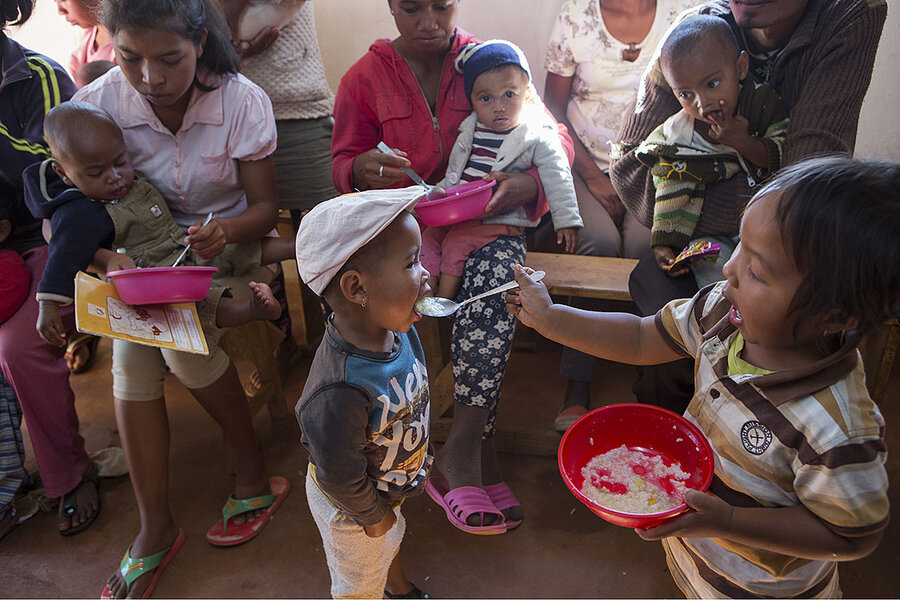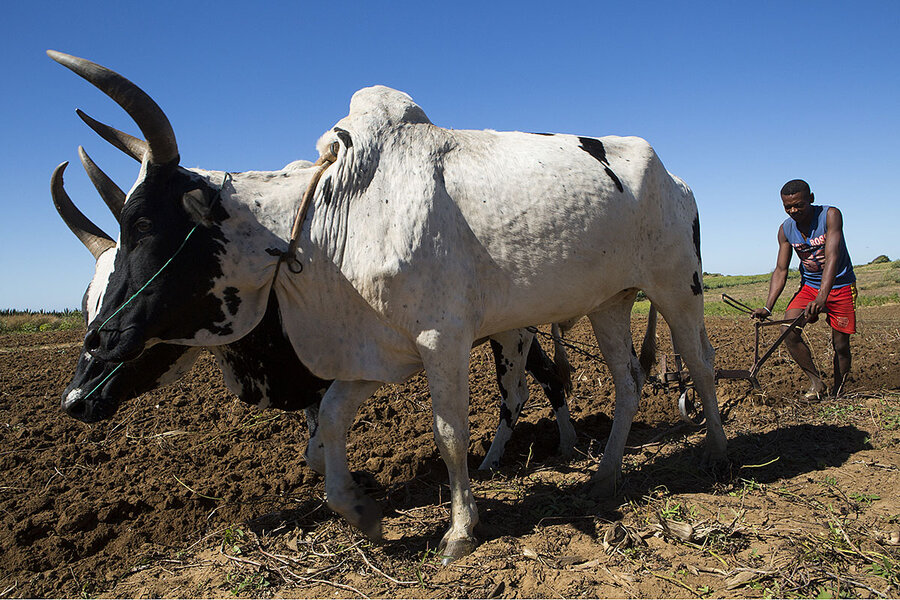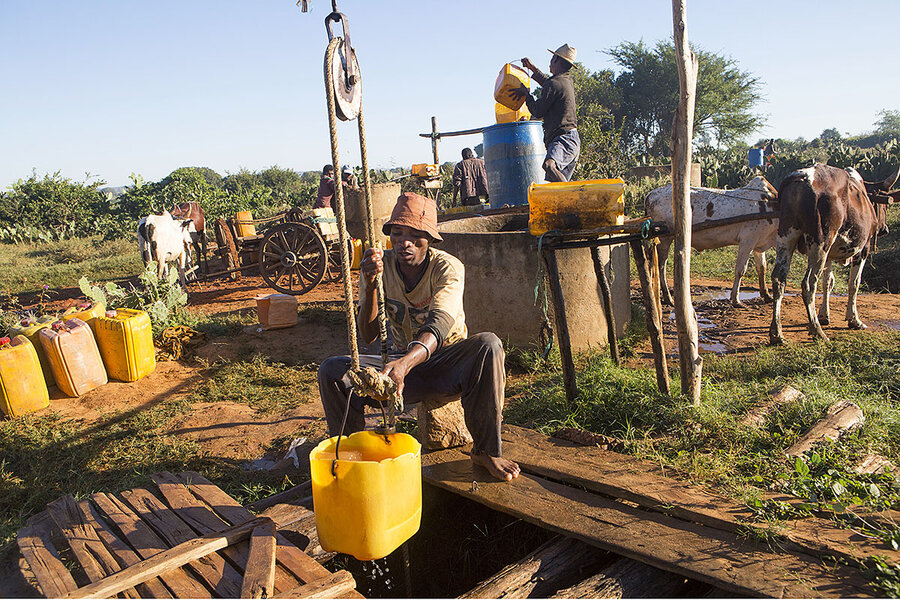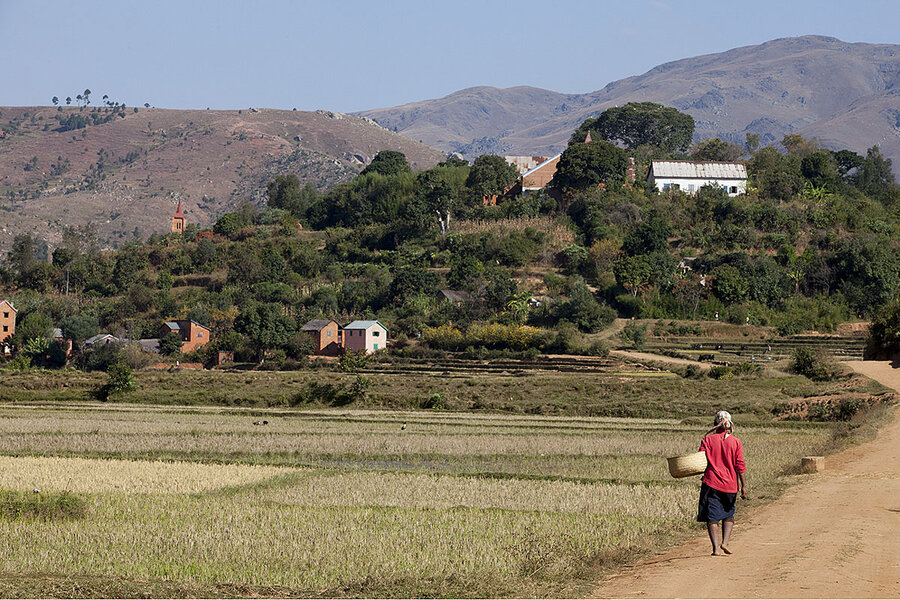Madagascar nears a first: Famine caused by climate rather than war
Loading...
| Johannesburg
All modern famines are human-caused, typically the result of conflicts that displace people and cut off access to food. In southern Madagascar, though, the trigger for its food crisis is four years of successive droughts in a country in which most people live on less than $2 a day.
Activists say that Madagascar’s crisis is grave, though it is not unfixable. Communities need better ways to treat and store water and to forecast extreme weather, as well as a greater say in how the international community responds to such crises.
Why We Wrote This
Climate-related drought has pushed Madagascar to the brink of famine, serving as a warning to the rest of the world. How Madagascar handles its crisis could be a model of adaptation.
The severity of the situation, which is affecting more than 1.5 million people, has already raised the profile of Madagascar and its exposure to global warming.
“When you are hopelessly relying on the weather to bring you your livelihood, your food production, your life, and that lets you down for four years, it pushes you to an extreme situation,” says Shelley Thakral, a spokesperson for the World Food Program.
When Madagascan climate activist Christina Kolo got the chance in April to speak to United Nations Secretary-General António Guterres, she wanted him to know two things.
First, people in Madagascar were already suffering as a result of climate change, which had made their weather more extreme and pushed millions toward hunger.
But if they were among climate change’s first victims, she then told him, they could also be on the frontlines of the fight to help the world adapt to it.
Why We Wrote This
Climate-related drought has pushed Madagascar to the brink of famine, serving as a warning to the rest of the world. How Madagascar handles its crisis could be a model of adaptation.
“Most often in international media we see calls for more food, more aid to help people who are suffering” in countries like Madagascar, she says. But while humanitarian aid is important, “we also want solidarity,” she adds.
Rains have failed in parts of southern Madagascar for five out of the past six years, leading the U.N. to warn that the region is on the brink of the world’s first “climate change famine.” Experts say its crisis should be a warning to the rest of the world as average temperatures rise and weather becomes more extreme and unpredictable. But for activists like Ms. Kolo, how Madagascar handles the crisis could also be a model for a more resilient world.
She and others working in drought-stricken regions of the southern African island nation say that while Madagascar’s crisis is grave, it is not unfixable. People there need better ways to treat and store water and to forecast extreme weather and, where possible, plant alternative crops. They also want a bigger say in how international decisions about their crises are made.
But those solutions hinge on people in richer nations not seeing hungry people in places like Madagascar as “statistics, from a small faraway country,” Ms. Kolo says, but as real people suffering as a result of a global crisis.
“This is about the collective moral responsibility we have around climate change,” says Shelley Thakral, a spokesperson for the World Food Program (WFP) in southern Africa. “It’s countries like Madagascar that have borne the heavy plight of cyclones and other climate shocks despite having done almost nothing to contribute to climate change.”
From conflict to climate
All modern famines are human-caused. And for decades, they have mostly been made by conflict. Countries like Somalia, Ethiopia, and Yemen have had famines – a global classification for severe starvation crises – when people fled violence and lost access to food supplies.
What makes the situation in Madagascar unique, Ms. Thakral says, is that war has played no role in its hunger crisis. Instead, in a country where three-quarters of people live on less than $2 a day, several years of devastatingly dry weather have withered the food crops on which communities depend.
“When you are hopelessly relying on the weather to bring you your livelihood, your food production, your life, and that lets you down for four years, it pushes you to an extreme situation,” she says.
As of August, 14,000 people in the far south of Madagascar were living in “famine-like conditions,” according to WFP surveys, and another 1.5 million were at great risk of falling into this category. Many people are surviving on cactus and other wild plants.
The region’s successive droughts aren’t a direct result of climate change, but their effects have been cranked up by rising temperatures and climate volatility, says Chris Funk, director of the Climate Hazards Center at the University of California, Santa Barbara, which works on early warning systems for extreme weather events.
“Climate change amplifies natural changes and has contributed to the drought in Madagascar,” he says.
Knowing that, he says, he and other researchers are creating new models for drought forecasting, which have already helped to predict recent droughts in southern and eastern Africa. That, in turn, makes it easier to get emergency food and resources to those places before it is too late.
Gender issues at the fore
In Madagascar, nonprofit organizations are helping communities build better water storage and treatment options, which could help mitigate future droughts.
Ms. Kolo’s organization, Ecofeminism Madagascar, focuses on how weather crises increase violence against women, and what to do about it. As in many rural societies, the task of water collection often falls on women and girls, and when drought forces them to scour more remote places, the risk of violence goes up. Moreover, when families are desperate for fewer mouths to feed, they may opt to marry off young girls.
“Climate change and gender issues are very closely related,” she says.
Ms. Kolo often attends international conferences and works with climate movements in other parts of the world, which she says is important for building a shared sense of responsibility around crises in places like Madagascar.
“For me, it’s not the time to say to people in the ‘Global North’ anymore that they must feel guilty,” she says. “But they must make demands on people in power where they live, who have the power to make change for the world. It’s time for them to show us some solidarity.”











